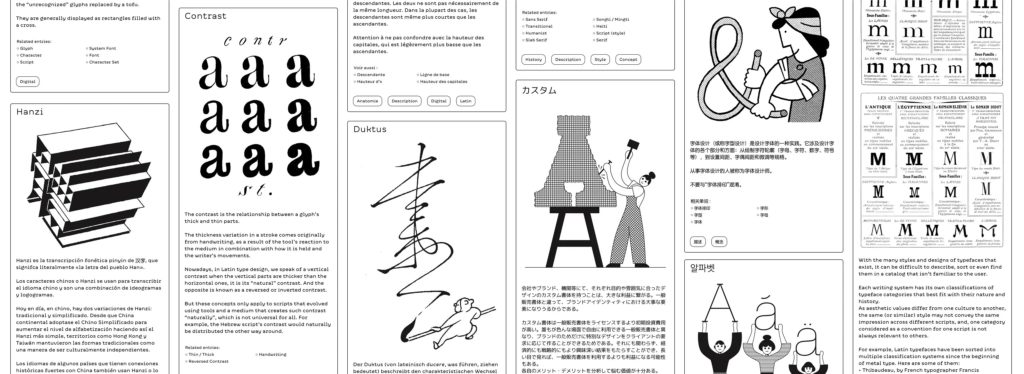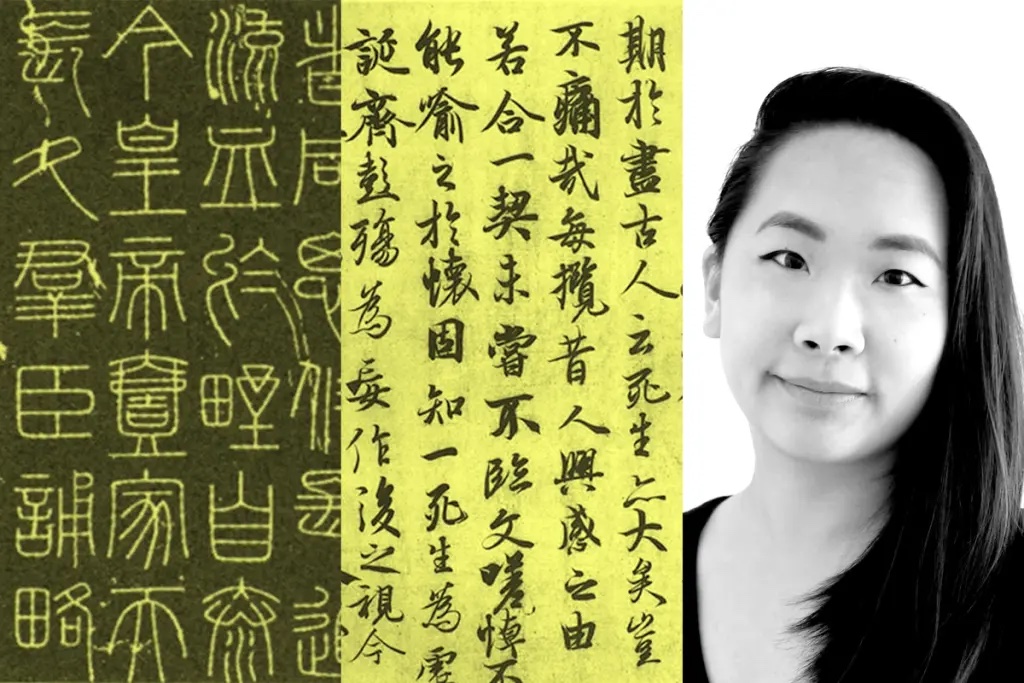The last time Lisa Huang shared a Very Cool Thing on Alphabettes, she published her research on Noto Sans Nüshu script, and the community of women behind it. Two and a half years later, Lisa is back to answer some questions on her newest Very Cool Thing, Words of Type.

Tell us about your new project and Kickstarter campaign!
Words of Type is an encyclopedia of typography, with each term illustrated, described and explained into multiple languages. Each term is explained in concise and straight forward terms to be easily understood, and illustrated by multiple artists to bring visual variety and fun. To bring the various typographic cultures closer together, there will be not only terms from Latin typography, but also those of other writing systems. To give a (literally) better access to typographic knowledge, it’s going to be a website that gives free access to everyone, everywhere. And it will grow and evolve over time, with more languages and words.
How did you get interested in type and typography?
I always had an interest in drawing since I was able to hold a pen. It was kind of the only activity that my Chinese parents would allow me to do, even though they started to worry that I’d become an artist in the future (not the dreamed job for their daughter). And reality came quite close to this, as I found myself happy only during art classes in high school. So I applied to an art school in Paris, without especially knowing what I wanted to do afterwards. And by the time we had to pick a direction for the Masters, I found that the most interesting section would be Typography, because it merges several aspects that are both interesting to me, and with better career prospects (my thinking as a student). And I got really “hooked up” by the type design classes given by Jean François Porchez, who shared so much about his knowledge and passion. I realized that typography and type design are the combination of even more than I thought: art, craft, technology, history, culture, even sometimes sociology, psychology, etc. Between the “Chinese life” I had at home with my parents trying (very hard) to keep the Chinese culture on the upper hand and everything being my “French life” outside of home, I keep trying to (peacefully and gracefully) meet these French and Chinese culture. It’s not an easy task, there are plenty of ways to approach that challenge. But I guess that typography—because it has a lot to do with culture, there is plenty of work to do in multiscript typography, and I believe that I’m not so bad at it 🙃—is a good way to approach that.

Where did the idea for Words of Type begin?
Since I studied typography, there were many books or articles that are written only in English. French education being what it is, I had to learn typography AND English at the same time. And most of the time, dictionaries don’t have a good translations for these specific words… While I kept studying in other places abroad, I could improve my English a bit along with my knowledge in typography. Then, as I work with people from different countries, I could only see that this issue happens to everyone, all the time.
Another thing is that, books are the greatest resources to learn about anything. I personally learned everything from books. But as physical objects, they carry issues of the physical world: impossible to modify when it’s published, quickly out of print, and with a fixed price, it can cost too much for some people (without including the shipping costs).
So, I could see the issues, but it took me some time to figure out 1. how to address that, and 2. if I’d be the good person to take on this project, and when (I know I know, impostor syndrome… still trying to figure that out).
With the (amazing) people I met during my studies and career, who inspired me (still today, and always), the question of working on such project as Words of Type slowly grew bigger. As everyone I talked to about it see the need of it, and, so far, no other project of such extent already exists. Many books on typography have a glossary of those terms, but it’s in a limited number of languages, and not every word one might need to look for is there. A few foundries are also working on an online version, or a document sent to their clients, but it’s only in the languages that they use. Quite recently, Google has launched Google Fonts Knowledge with a Glossary, created by Eliot Jay Stocks. It is great, but it’s only in English (for now?), and many words are about the use of the fonts from their library. By now, I’m quite used to challenged at work (think of Chinese typeface design and production…). So, with the help of the many friends and colleagues, I though, why not? 🤪
What are a few of the most challenging terms to translate across different languages?
With the people helping me with the translations, we’ve been working on this since not so long ago. I didn’t feel like asking them to do too much work for free. But some words like “Kerning” or ”Hinting” are quite difficult to translate, because they don’t EXIST as an individual word in many other languages, and designers just use the English word even when they are speaking their own language. The word “Typography” (I know!!) is also challenging to translate into Chinese, for example. Because Chinese history with typography isn’t as long as that of Latin script, and teaching typography has started only quite recently. So, there are many diverging opinions about determining what exactly is ”Typography”: as in typesetting? the fonts as products? the design of the characters? All these terms need to be reviewed with as many professionals as possible to find a common ground… And I’m sure that there are similar issues with many other languages and scripts! Words of Type could also be like a reason to make all that happen!
How did you choose your collaborators?
For the translations, I hesitated to reach out to professional translators for each language. But the thing is, typographic vocabulary being sooo specific, not known (or not well enough to provide a clear translation), I’d have to spend a lot of time explaining each word, and a lot of money too (I’ve spent most of my savings on preparatory work and research already…). So I asked friends who are type designers and typographers, whom I know have experience explaining the terms in English or their own language, and, because they are friends, I felt confident enough asking for their help for free, at least for the 30-ish words translated for the campaign as a preview of what Words of Type could be. This is a collective effort. As a tool for people, it can’t be made by a few and be considered as information that are carved in stone. So more funding would allow me to hire more people for reviews, feedback, and other improvements if needed, even with the great work already provided by the collaborators who helped me so far.
Tell us more about the rewards of the campaign. How did you come up with the idea of lectures and workshops as rewards?
I figured that with a digital project like Words of Type, offering physical objects wouldn’t be so relevant with the whole concept. At least for now, because I honestly didn’t feel like getting into managing printed or manufactured goods, to be designed, produced, and shipped worldwide. A Kickstarter campaign was already a LOT to handle. So, I thought to plan a selection of lectures and workshops on type design in many different scripts. The same kind of events from which I personally learned a lot, and to which I intend to keep learning from! So getting either one of the lectures or workshops would be like a “two birds – one stone” decision: learning something great (and not offered so often, for some scripts like Thaï with Boom Suksumek, or Hebrew with Shani Avni, and so many others) AND supporting a great project 🙃

What is the most stressful part about doing a Kickstarter campaign?
It took me some time to actually get into preparing a Kickstarter campaign for Words of Type. I knew that, because I’ve never done such thing before, there will be many unknowns (and I prefer to know what I’m doing!). And I was right… The most stressful part is to not know how many people would contribute, how much, and when, and why they don’t contribute right away! 😆
I’m always worried (even with the positive reaction on social media) that the targeted goal might not be reached on time… But I do my breathing and focusing exercises to keep a positive spirit. The project seems to get many people’s interest. The Instagram account keeps seeing its number of followers growing day by day. I’m not much of a communication person. I know nothing about marketing strategies, because it’s not what I prefer. But for something that is important to me, I’m fine stepping into (VERY) unfamiliar grounds. And for that, I’m extremely grateful to have friends and be in the supportive community of type designers!
When you’re not thinking about type, what are you doing?
Besides typography, I, LOVE, FOOD. Not only eating, but also cooking, learning about whatever there is to learn about it, and not only Chinese or French cuisine. My family is very deep into Chinese cuisine. As a family of immigrants who left their homeland for the hope of a better (material) life, everything was about earning money with whatever they could do, which is cooking, and food. So I kind of have this super deeply rooted interest for food. Even more when I realized how strong the link between culture and cuisine is!! Probably stronger than that between culture and typography… But I can’t imagine myself owning a restaurant, like my parents hoped at some point, for so many reasons (if you’ve seen the super great show The Bear, you’ll know what I mean).
Thanks, Lisa! For more information about Words of Type or to help make it a reality, join the Kickstarter and share with friends 🖤